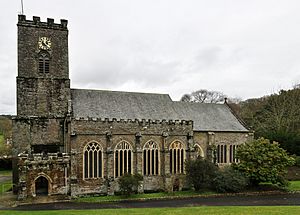St Germans Priory facts for kids
Quick facts for kids Church of St Germanus, St Germans |
|
|---|---|

St Germans priory church, St Germans
|
|
| Location | St Germans, Cornwall |
| Denomination | Church of England |
| History | |
| Status | Parish church |
| Consecrated | 1261 |
| Architecture | |
| Style | Norman and Gothic |
| Specifications | |
| Materials | Stone and rubble |
| Administration | |
| Diocese | Truro |
| District | Archdeaconry of Bodmin |
St Germans Priory is a big church in the village of St Germans, located in south-east Cornwall, England. It was built in the Norman style, which means it has thick walls and round arches. This historic building has been an important place for many centuries.
Contents
The Priory's Long History
Early Beginnings and Bishops
People believe that Saint Germanus himself founded a church here around 430 AD. The first written record shows Conan becoming a bishop in the Church of St Germans. This happened because of an agreement between King Athelstan and Cornwall. Having a bishop's main church, called a "see," here showed that the Celtic monastery was already very important.
In 926 AD, King Athelstan made this church the cathedral for Cornwall. A cathedral is the main church for a bishop. However, this didn't last long. In 1042 AD, the bishop's see moved to Crediton.
Monastery Life and Changes
A monastery grew next to the church over time. Monasteries are places where monks or nuns live and worship. Between 1161 and 1184, the Bishop of Exeter reorganized the monastery. It became an Augustinian priory. A priory is a type of monastery, usually smaller than an abbey.
The priory church was then rebuilt to be very grand. It had two towers at the west end and a long main hall called a nave. The nave was about 102 feet long.
The End of the Priory
During the time of King Henry VIII, many monasteries in England were closed down. This event is known as the Dissolution of the Monasteries. St Germans Priory was closed, and its buildings became a private home. This home belonged to the Eliot family, and it still does today. Many members of the Eliot family are buried in the church.
Today, St Germans Priory is looked after by the Church of England and a group called the St Germans Priory Trust.
Amazing Architecture and Art
Norman Features and West Doorway
Some of the original Norman parts of the church are still there. One special feature is the large arched western doorway. It is very fancy and has detailed carvings. The stone used for these carvings is called elvan.
Inside the Church
The church has a special chapel for the Moyle family, where they are buried. You can also find a magnificent Baroque monument inside. It is made of black and white marble. This monument honors Edward Elliot (1682-1722), who was a Member of Parliament. A famous artist named John Michael Rysbrack created this sculpture in 1723.
Beautiful Stained Glass Windows
The church has a large east window with five sections. It was filled with stained glass in 1896. The designs were made by Edward Burne-Jones and created by Morris and Co.. The window shows ten figures in two rows. In the top row, you can see Christ in the middle, with a centurion and Saint Mary on one side, and Saint Mary Virgin and Saint Paul on the other. Below them, Saint Stephen is in the center, surrounded by the Four Evangelists: Matthew, Mark, Luke, and John. Above them, there are angels.
There are also two other windows on the south wall with three sections each. These windows also have stained glass designed by Burne-Jones and made by Morris & Co. They were put in the church in 1902. These windows show figures that represent different good qualities, like virtues.
The church also has a pipe organ with two keyboards. It is located on the left side of the church. The church has two towers, which makes it look even more impressive.
Other Burials
- John Eliot, 1st Earl of St Germans
- Henry Eliot, 5th Earl of St Germans
- John Eliot (died 1685)
- Edward James Eliot
- Edward Craggs-Eliot, 1st Baron Eliot
See also
- Bishop of St Germans
- List of cathedrals in the United Kingdom
- List of English abbeys, priories and friaries serving as parish churches
Images for kids





